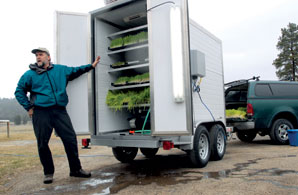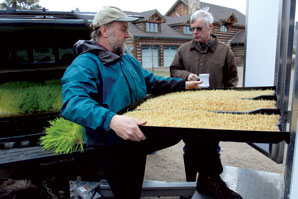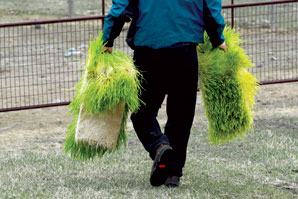Ron Doore, a Cut Bank farmer, has been trying to figure out a better way to feed his livestock for years. Hydroponics always seemed interesting, though not entirely efficient. But now he believes he’s found the right system, and he’s even converted one of his biggest skeptics.
“In an ironic way, my dad was my toughest critic,” Doore said. “Now that he’s got to use the product firsthand, he’s probably one of my better indirect salesmen.”
Doore, owner and president of Sun Roads Farmory, began selling self-contained hydroponic growing chambers last year. The chambers produce mats of sprouted grains and legumes used for livestock fodder. He touts the quality of the fodder – high protein content and nutritional value – and its overall cost effectiveness.
 |
|
David Oberst gestures to a trailer attached to his vehicle while describing how they hydroponic growing system works to produce mature barley in six days. |
David Oberst, Sun Roads Farmory’s vice president of marketing and business development, adds that hydroponics requires virtually no acreage or farm equipment, and uses no soil, thereby significantly reducing the carbon footprint of agriculture. Oberst believes hydroponics, when harnessed into an efficient system, has the potential to dramatically improve modern agriculture.
Five years ago, Doore was exploring the possibilities of hydroponics when he heard about a company called Fodder Solutions out of Australia. Fodder Solutions manufactures and sells hydroponic growing chambers that sprout grain and legume seeds in less than a week – “seed to feed in six days.”
Fodder Solutions had begun to gain popularity in Australia, but had no presence in the U.S. when Doore sparked up discussions with the company’s founder. After several years, the company decided to open U.S. operations and joined forces with Sun Roads Farmory. Today Doore is in charge of a seven-state marketing area for Fodder Solutions and is preparing to broaden his range.
There is little groundbreaking about Fodder Solutions’ technology, as hydroponic growing is nothing new and is widely used in Europe. But rather than inventing new worlds, Doore said Fodder Solutions’ chambers have simply found a workable and efficient balance of existing technology.
“There’s nothing really super magical about it,” Doore said “It’s the delivery system, if you want to call it that, and the technology. We’ve put the technology into a process where it’s ready to use and it’s easy to maintain.”
Hydroponics has been slow to catch on in the U.S., largely because, Doore believes, other systems haven’t been cost-effective, particularly at the agricultural scale. Growing fodder for 1,000-pound animals is a different ballgame than growing veggies for humans. Other operations have mold problems or other issues, Doore said.
When Doore was stationed overseas in the Army, he visited Belgium – what he calls the “hydroponic capital of the world” – and was fascinated by the country’s agriculture. He began researching hydroponics when he returned home, believing it could be useful on his Montana farm if properly applied.
 |
|
David Oberst, left, pulls a tray of barley seeds out of a hydroponic growing chamber to show Jim Watson the different stages of the growing process at Spring Brook Ranch west of Kalispell. Watson was trying out the fodder to see how his animals responded to the new feed. |
Sun Roads Farmory’s smallest unit costs $9,800 and the largest, the T-126, costs $33,600. The T-126 is 19 feet long, 11 feet wide and 11 feet high and can produce a half-ton of fodder – barley sprouts, for example – per day, or enough for 126 animals that are 800 pounds each, Oberst said. Far greater capacity – multiple tons per day – could be on the horizon and is already available in Australia, he added.
Oberst said a farmer can recover the initial purchase cost in 12-24 months, while pointing out that the farmer can also save on expenses – both in terms of money and impact to the land – associated with farm equipment and transporting feed.
Oberst, who lives in Kalispell, has been hauling around a demo unit on a trailer to show to ranchers around the state. The regular units are built as permanent structures at the farm, though Oberst said portable models are available as well.
Seed trays are placed on shelves inside Sun Roads Farmory’s hydroponic growing chambers. Barley seeds are common, but any grain or legume can be grown, from alfalfa to lentils. A computer system monitors a scheduled misting system to water the sprouts. Grow lights are located within the enclosed chambers and the temperature is computer controlled.
Sprouts can be seen by the second day and by the sixth day the plants have reached their maximum nutritional value and are ready to be given to the animals. When removed from the trays, the sprouts appear as densely vegetated, rectangular mats – almost like sod squares. These are called “biscuits” and are fed to the animals, root mass and all.
Because the sprouts are alive, the nutritional value is amplified, Oberst said. The animals get nutrition from the grain seed, living matter and roots – there is no soil to worry about. A pound of the fodder, he said, is equivalent to three pounds of normal livestock grain. The fodder’s protein content is high.
Oberst is a certified living foods lifestyle consultant who was already involved in growing food through hydroponics for human consumption before he met Doore at the fair last summer.
“People say, ‘We feed (our animals) 30 pounds of grain a day,’” Oberst said. “Why don’t you just feed them 10 pounds per day of living grain?”
He added: “You’re not wasting any energy or nutrition. It’s all there.”
Doore said the units are best suited to provide supplemental fodder to the livestock’s regular grass foraging and alongside hay. But because of the high nutritional value, Doore said the fodder, in some instances, can single-handedly replace all other supplemental rations, save for mineral licks. A lot of ranchers, he said, feed their animals five different rations or more to achieve proper nutrition balance.
 |
|
David Oberst carries “biscuits” of barley to a corral of horses on the Spring Brook Ranch property west of Kalispell. The barley grows “from seed to feed” in six days. |
Fodder Solutions is still in its infant stages of U.S. marketing, but Doore said 50 units have been sold, including two in Montana. Doore uses two units on his ranch, and he said he has seen significant improvement in the performance and behavior of his saddle horses. Sun Roads Farmory was recently featured in the agricultural publication Prairie Star.
Sigurd Jensen, who owns Chief Cliff Quarter Horses in Elmo, had Oberst’s demo unit on his ranch for three days. He said “he’s kicking around the idea” of whether to buy one, but would like to talk to somebody who already has the system. He likes the high quality of the feed, the year-round stability and overall price, particularly in light of high hay prices.
Jensen said, because of the nutritional value, the fodder could be particularly useful for ranchers trying to put weight on their animals. Some of his horses and cows were skeptical of the food, while some liked it almost too much.
“This has been around for a long time, but there weren’t machines like this before,” Jensen said. “It’s definitely something I’m going to be looking into. It’s kind of, ‘Do I make the transition?’”
Oberst took the demo unit to the yak and buffalo ranch of Jim Watson and Carol Bibler outside of Kalispell last week. Like with Jensen’s livestock, some of the animals loved the barley “biscuits” and others were hesitant. But Watson figured, over time, they would all grow accustomed to it. Oberst hopes they get the chance to, as do many other animals.
“I want to facilitate a paradigm shift,” Oberst said. “To be part of that, it gives me goosebumps.”